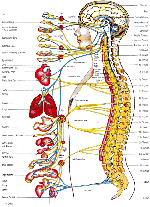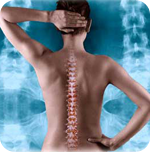


Chiropractic Theory
Joint restrictions lead to biomechanical restrictions, friction, inflammation and eventually degeneration.
Chiropractic manipulation releases joint restrictions to restore normal range of motion. The Chiropractic adjustment helps to break up the restrictions of fibrosis that forms around spinal joints. These restrictions cause friction and increased stress on the normal joint function. This increased friction may cause inflammation or just wear and tear of the joints.
This wear and tear is no small matter. Wear and tear causes Osteoarthritis, a progressive breakdown of cartilage. The cartilage is a very thin layer inside the joint. Thus it becomes very important to remove stress from the joint in order to prevent complete degeneration of the cartilage. Twelve percent of the population suffers from severe osteoarthritis.
It is very important to restore joint function if you are experiencing an inflammatory reaction as a result of these joint restrictions, particularly if you have been experiencing repeated episodes of inflammation. Repeated episodes often lead to chronic problems which effect the surrounding structures: joint capsules, ligaments, muscles, and nerves.
Spinal manipulation is a very effective way of alleviating these types of restrictions and preventing further problems.
Chiropractic Manipulation also effects soft tissue, not just the bones.
Patients often ask me how an adjustment of an osseous structure (Bones) can affect soft tissue (muscles). The answer is really quite simply. In your muscles you have stress receptors called Golgi Tendon Organs. These stress receptors react to situations where muscle tension suddenly increases such as with a Chiropractic Adjustment.
These adjustments are low in force but high in velocity. This causes the stress receptors (Golgi Tendons) to inhibit all muscle activity in the surrounding area. It literally causes the entire muscle surrounding the joint to go into an instantaneous state of relaxation. A very important function when you are dealing with an acute episode of low back pain. (Guyton Textbook of medical physiology p691-692) This is why chiropractic adjustments when performed correctly are done very fast but with very low force.
How Manipulation effects the nervous system
This is by far the most important aspect of chiropractic manipulation. For years chiropractors have hypothesized on how adjustments effect the nervous system, we now can scientifically expand how this works. We can also validate our claims with research from the conventional research community. By conventional I am talking about accredited allopathic medical journals in the world not Chiropractic research. Some times I hear there is no scientific information out there to validate Chiropractic. Obviously these individuals are not familiar with current literature.
One of the central hypothesis of the chiropractic theory is that dysfunction of the musculosketetal structures ( Relating to or involving the muscles and the skeleton) have a significant impact on the autonomic nervous system.
The autonomic nervous system is the part of your nervous system that controls involuntary activities, including heart muscle, glands, and smooth muscle tissue. The autonomic nervous system is subdivided into the sympathetic and parasympathetic systems.
Abnormal neurological input from dysfunctional musculosketetal structures (ie. injury, inflammation) increases sympathetic traffic or activity in this system. The sympathetic system is responsible for the "fight-or-flight" response we are hard wired with.
An injury to the musculosketetal system result in an overall increase in the sympathetic nervous system activity. In fact injury to this system will cause a shift of the autonomic nervous system towards sympathetic dominance.
The flight or fight response, also called the "acute stress response", was first described as early as the 1920's. The response was later recognized as the first stage of a general adaptation syndrome that regulates stress responses.
The onset of a stress response is associated with specific physiological actions in the sympathetic nervous system, both directly and indirectly through the release of the hormone epinephrine and to a lesser extent norepinehrine from the adrenal glands (medulla). These are stress related hormones.
The release of these hormones is triggered by a substance called acetylcholine which is released from the sympathetic nerves. Acetycholine is a neurotransmitter in the brain which helps to regulate memory, the actions of skeletal and smooth muscle in the pheripheral nervous system.
These hormones ( epinephrine and norepinehrine) facilitate immediate physical reactions by triggering increases in heart rate and breathing, constricting blood vessels in many parts of the body - but not in muscles (vasodilation), brain, lungs and heart - and tightening muscles.
How motion restriction influences neurological function - Pain Gate Therapy
Injury to the back often involves injury to the facet joints of the spine or to the discs. These injuries are often caused by the non-voluntary contraction of the spinal segmental mover (muscles around the spine contracting such as the multifudus muscle). These non-voluntary contraction occur not only at the level of injury but several segments above and below the level of injury.
This non-voluntary movement contraction locks what is referred to as the motor unit (two adjacent vertebrae, the disc between them, the nerves that goes through them, and surrounding soft tissues) into a certain position with reduced movement.
This has the effect of opening what is called the "Pain Gait". Initially the Pain Gait theory was proposed in 1965 by Melzack and Wall based on the fact that small diameter nerve fibres carry pain stimuli through a 'gate mechanism' but larger diameter nerve fibres going through the same gate can inhibit the transmission of the smaller nerves carrying the pain signal.
Chemicals released as a response to the pain stimuli also influence whether the gate is open or closed for the brain to receive the pain signal. This leads to the theory that the pain signals can be interfered with by stimulating the periphery of the pain site, the appropriate signal-carrying nerves at the spinal cord, or particular corresponding areas in the brain stem or cerebral cortex.
It is generally recognized that the ' Pain gate ' can be shut by stimulating nerves responsible for carrying the touch signal ( mechano-receptors) which enables the relief of pain.
How this relates to Chiropractic Adjustments
When a Chiropractor adjustment adjusts a section of the spine they cause the firing in of what is called high threshold mechano-receptors. This initiates a neurological sequence of events that causes pain inhibition (closes the pain gate), and inhibits the sympathetic nervous system. Considering the wide spread effects of being in a constant state of flight or fight, the ability to reduce these sympathetic activities with an Chiropractic adjustment is quite amazing.
Poor healing of the back always results in fibrosis of scar tissue formation and adhesions. Chiropractic spinal adjustments are unique in their ability to break up these adhesions, close the pain gait, reduce involuntary sympathetic nervous system activity, and improve over all function.
Journal of Manipulative and Physiological therapeutics January 2005, volume 28, Number 1
Chronic Spinal Pain: A randomized clinical trail comparing medication, acupuncture, and spinal manipulation Spine July 15, 2003;28(14):1490-1502
Gate control Theory of pain stands the test of time British Journal of Anesthesia. Vol. 88, No6, June 2002, Pgs. 755-757
Less side effects and a safe alternative.
Research shows that chiropractic is significantly safer than comparable pharmaceutical and surgical treatments, and produces far fewer (4,000 times fewer) negative side effects. To further understand chiropractic's effectiveness, the Canadian chiropractic profession is currently involved in additional research to further examine neck adjustments. Recent research conducted at the University of Calgary, demonstrated that neck adjustment is done well within the neck's normal range of motion; that no force is applied to arteries during an adjustment; and that arteries are not stretched during adjustment.
Internal forces sustained by the vertebral artery during spinal adjustment therapy, Herzog W, Journal of Manipulative and Physiological Therapeutics, Oct. 25(8): 504-20, 2002.














